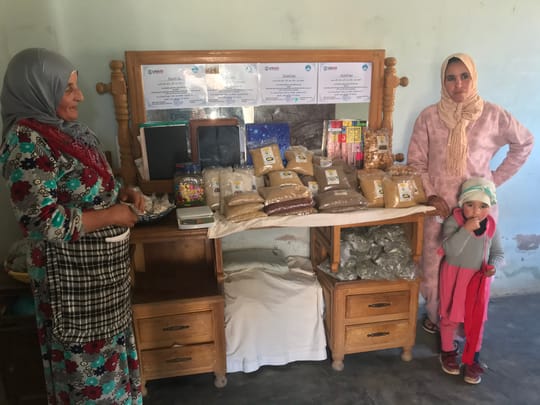From Ghmat to Sidi Ali Afaress: Discovering Rural Morocco

HAF Intern
I am attending my first tree planting: I’m almost overcome with emotion. Amina and the farmers discuss future projects that High Atlas Foundation (HAF) might consider with them if the trees planted today grow well. If they do, it will allow many new trees. Amina insists on the importance of education. Indeed, in the village, the school has only existed since 2000. Nevertheless, it’s important for children to get their fill of knowledge.

HAF distributed only organic fruits trees (almond, olive, fig, and carob). Then, we shared breakfast with villager members. All the products are homemade: bread, butter, honey, eggs…
The way back offered me another point of view, for despite all this greenery, the vegetation and all its ecosystem coexist with a plethora of plastic waste.
In the middle of the mountains, some summits are snow-capped, which seems unbelievable. We are with several women, including Malika, the president of this cooperative created in June 2019. This cooperative started with one woman and has grown to eleven. They produce different types of couscous, cookies and spices: organic and natural products. It is pleasant to be surrounded by women as smiling as they are beautiful, cheerfully offering us mint tea and baghrir (olive oil pancakes). The group told Amina about what they need to continue their activity: new packaging, a headquarters to promote their products, a place to breed more bees, and more tools for irrigation. They would like to see other cooperatives in other villages. For them, work is synonymous with independence, empowerment. But this thirst for a new kind of life is not always well-received, which can make it difficult to get started.

After this, we went with Malika to meet another group of five women in the village of Anamer. Discussions are held in Tamazight, the local language. There is disagreement between the group and Amina. For them, the carpets don’t sell fast enough because of a marketing problem; Amina says that they need more training because their carpets are not of a “professional” enough quality. Moreover, they idealize the role of the president of the cooperative, which makes voting complicated. Amina explained to them that the president doesn’t hold the “absolute power” and that she is not the only one who can make the cooperative succeed.
Later, we travel to Sidi Ali Afaress, a small village in the High Atlas. Five thousand fruit trees have already been planted there: carob, olive, almonds and also cypress because they protect the lands from bad weather. The next week, a thousand trees will be planted. These farmers have an iron will. We also met about 20 women of the village. They discussed with Amina what they are able to make for sale: cookies, almonds, honey, vinegar, carpets or jam. The discussions were promising: we’ll see what happens.

It’s time for us to come back in Marrakech. What an enriching day!
To conclude this first field trip day, I would say that I observed the combination of the three pillars of the sustainable development: economic, ecological and social. The farmers who are in charge of the growth of the trees see it as an economical advantage because the fruits produced give them income – which means a long-term vision that stands against the notion of “profit at any price.” The more trees grow, the more land is shaded by foliage and the more oxygen is produced. Moreover, no chemical products are used. Equally important, farmers are protected from unemployment.
It’s the same for the women’s cooperatives: working gives them independence, income, and a reason to get up in the morning; the products are natural and healthy. Yet, it’s not that simple. It’s through school that girl empowerment begins. Thanks to education, they will be able to emancipate themselves. To face up to this problem, it’s important to understand why their daughters don’t go to school. Indeed, the educational infrastructures sometimes do not provide bathrooms for girls, or they need more beds at dormitories, and parents with income for transportation. These are some of the different issues to which solutions must be found.